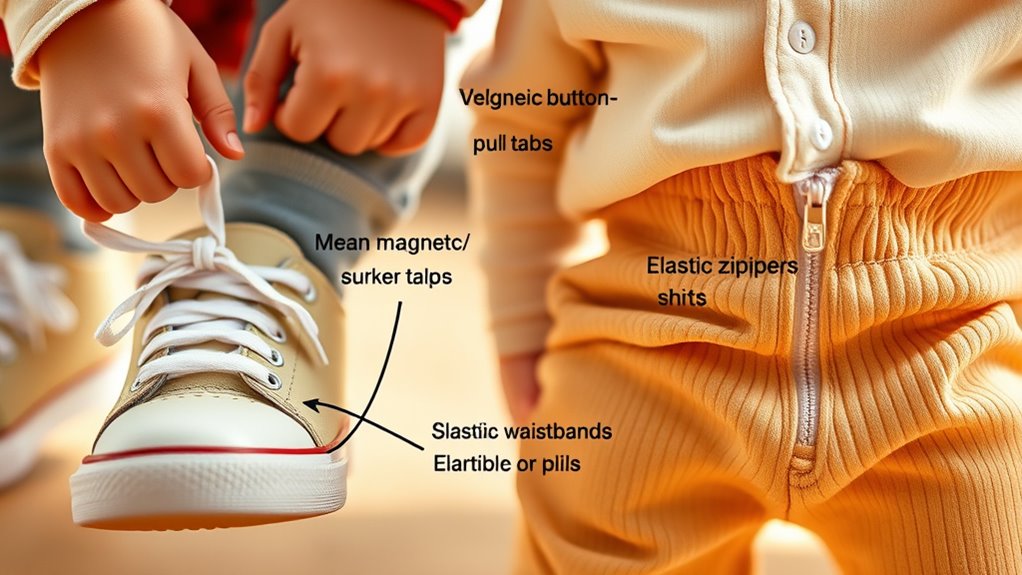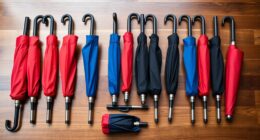Clothing adaptations that ease dressing include garments with large, easy-to-use fasteners like Velcro, magnetic closures, or snaps, which reduce frustration and effort. Features such as elastic waistbands, stretchable fabrics, and slip-on designs make dressing quicker and more comfortable. Sensory-friendly options, like tagless clothing and textured cues, support sensitive skin and improve orientation. To learn more about innovative solutions tailored for easier dressing, explore the functional and accessible clothing options available.
Key Takeaways
- Use garments with large, easy-to-manage fasteners like Velcro, magnets, or snaps to simplify dressing.
- Incorporate visual and tactile cues such as color coding or textured patches for quick identification.
- Design clothing with elastic waistbands, stretch panels, or wide openings for easier pulling on and off.
- Opt for tagless, soft fabrics to prevent skin irritation and enhance comfort during dressing.
- Include innovative features like magnetic closures and adaptive fasteners to reduce fine motor skill requirements.
Adaptive Clothing With Easy Fasteners
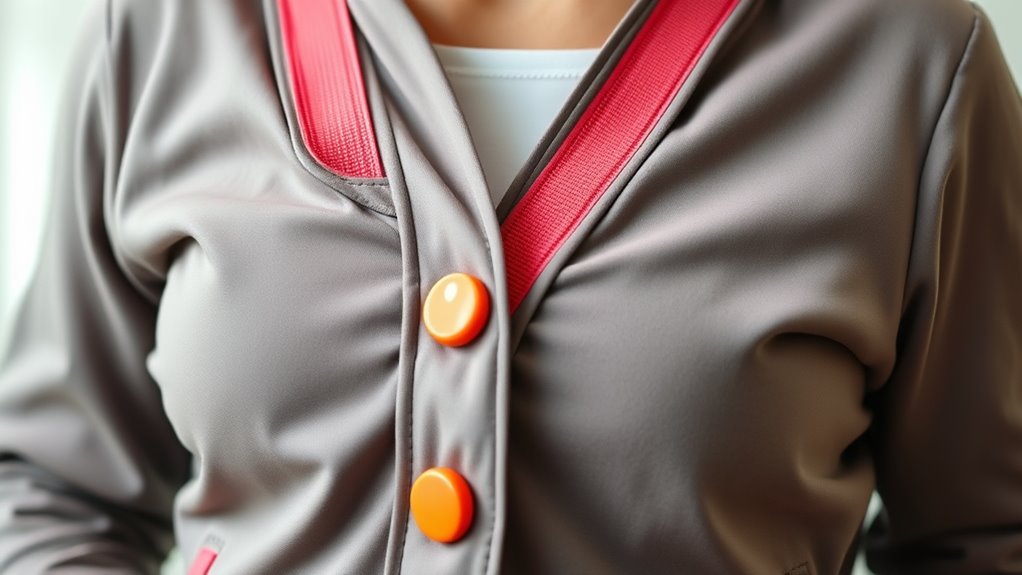
Adaptive clothing with easy fasteners is designed to make dressing simpler and more independent for people with mobility challenges. These garments feature closures like large zippers, Velcro, snaps, or hook-and-loop fasteners that are easy to grasp and operate. You won’t need to struggle with tiny buttons or complex zippers, which can be frustrating and time-consuming. Instead, you can quickly and confidently put on or take off clothing with minimal effort. This type of clothing reduces the physical strain and helps foster a sense of autonomy. It’s especially helpful for those with arthritis, limited hand strength, or coordination issues. By choosing adaptive clothing with easy fasteners, you make dressing smoother, safer, and more empowering. Additionally, incorporating high-quality fasteners ensures durability and reliability for repeated use. Incorporating adaptive clothing options that use reliable fasteners can also improve overall comfort and confidence during dressing.
Magnetic Closures for Simplified Dressing
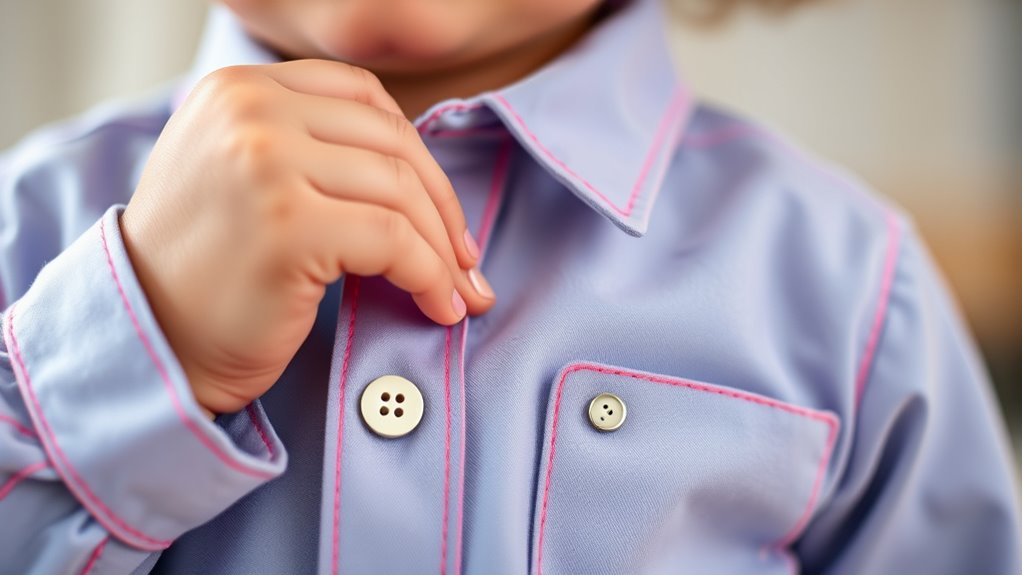
Magnetic closures are gaining popularity as an easy-to-use alternative for dressing, especially for those with limited dexterity or strength. They simplify fastening clothing by replacing traditional buttons, zippers, or hooks with magnets that snap together securely. You don’t need to align tiny parts or apply excessive force, making dressing quicker and less frustrating. These closures work well on shirts, jackets, and even pants, providing a sleek, seamless look. They’re especially helpful for individuals with arthritis, tremors, or mobility challenges. Installation is straightforward, and many magnetic closures are discreet, maintaining the garment’s aesthetic. Overall, magnetic closures reduce the effort needed to dress, promote independence, and boost confidence, making everyday routines smoother and more manageable. Necessary cookies can ensure the functionality of these closures and improve user experience through website performance tracking. Additionally, ease of use is crucial for encouraging consistent use and fostering independence in dressing activities.
Elastic Waistbands and Adjustable Fits
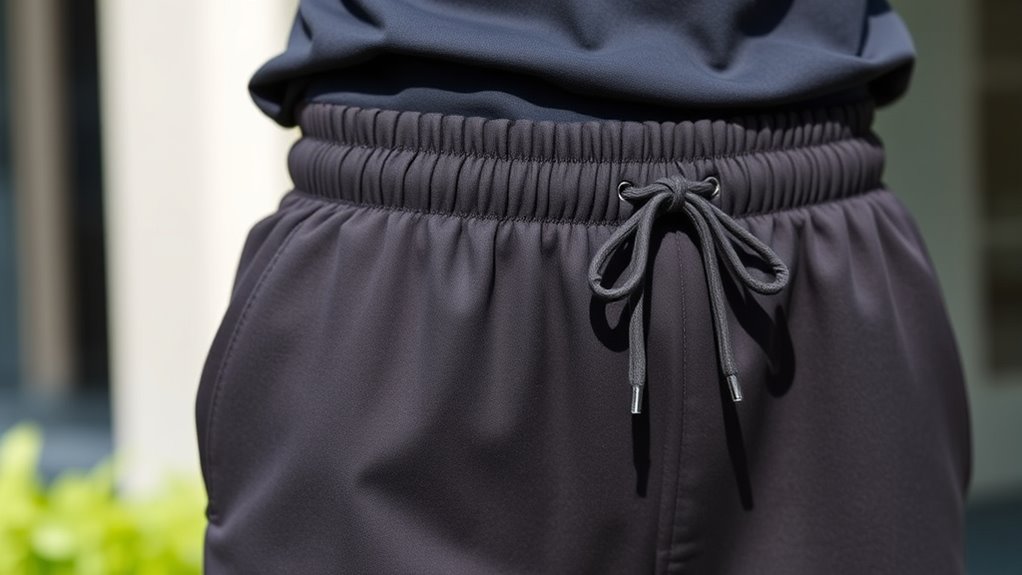
Elastic waistbands and adjustable fits make clothing more comfortable and flexible, so you can move freely throughout the day. They also simplify dressing, especially when you’re in a hurry or helping someone else get ready. Plus, they easily adapt to growth and changing sizes, ensuring a proper fit over time. Incorporating natural materials like linen and cotton can further enhance comfort and breathability.
Comfort and Flexibility
When it comes to clothing that prioritizes comfort and flexibility, elastic waistbands and adjustable fits play a crucial role. They adapt to your movements and changing body sizes, making dressing easier and more comfortable. You’ll notice less restriction and discomfort, especially during active moments or when your body changes throughout the day. These features also help in reducing frustration when dressing, since you don’t need precise sizing.
Consider these benefits:
- Provide a secure fit without pinching or binding
- Allow for quick adjustments as needed
- Accommodate weight fluctuations or growth easily
Easy Dressing Process
Choosing clothing with elastic waistbands and adjustable fits simplifies the dressing process, making it quicker and more straightforward. These features allow you to get dressed with less effort, reducing the need for precise fastenings or zippers. Elastic waistbands stretch comfortably around your waist, while adjustable options let you customize the fit as needed. This flexibility saves time and minimizes frustration during dressing.
| Feature | Benefit | Ideal For |
|---|---|---|
| Elastic waistbands | Easy to pull on and off | Limited mobility |
| Adjustable fits | Customizable comfort | Varying body sizes |
| No zippers or buttons | Faster dressing, less fuss | Busy mornings |
| Flexible materials | Comfort and ease during dressing | Sensitive skin |
Growth and Fit Adjustments
Since children’s bodies grow quickly, clothing with elastic waistbands and adjustable fits makes it easier to keep garments comfortable and properly fitting over time. These features allow you to adapt clothing as your child grows, reducing the need for frequent replacements. Elastic waistbands stretch with movement, providing flexibility and comfort. Adjustable fits, like drawstrings or snap closures, let you customize the size easily. This not only saves money but also promotes independence, as children can often adjust their clothing themselves.
- Provides flexibility for rapid growth
- Improves comfort during active play
- Supports independent dressing and self-care
Tagless Clothing for Sensitive Skin
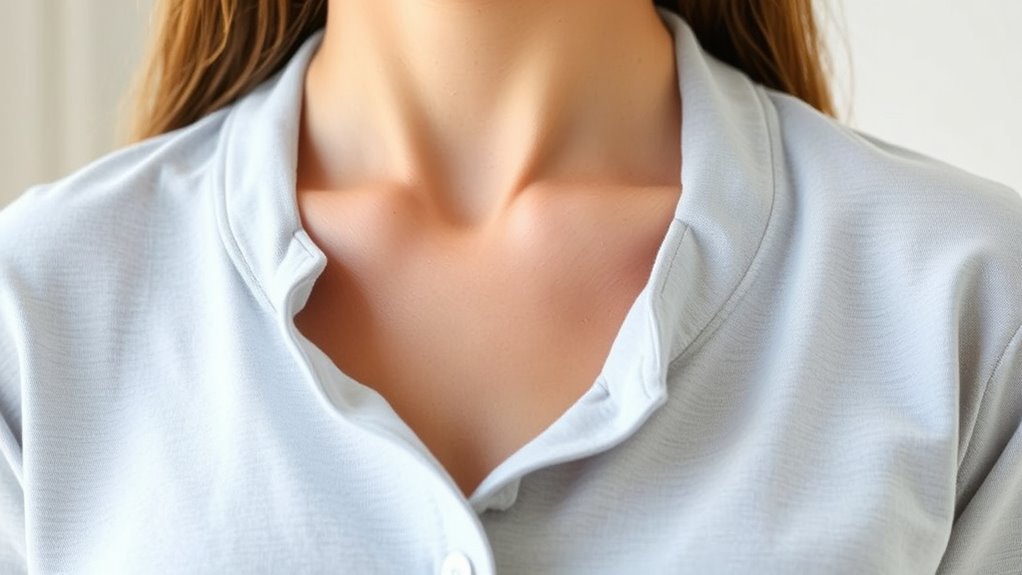
For people with sensitive skin, tagless clothing offers a comfortable and irritation-free option by eliminating the rough seams and tags that can cause discomfort. Traditional tags often irritate delicate skin, leading to itching and redness, especially during long wear. Tagless designs remove this annoyance, reducing the risk of skin irritation and making dressing easier. Many tagless garments are made with soft, smooth fabrics that feel gentle against the skin. They also prevent the need to cut or remove tags, which can sometimes damage clothing. This simple adaptation can markedly improve comfort, especially for those with allergies or hypersensitive skin. By choosing tagless clothing, you can enjoy a more comfortable, rash-free experience and focus on dressing with ease instead of battling irritation. Additionally, fabric softness plays a key role in minimizing skin irritation, making tagless options particularly suitable for sensitive individuals. Incorporating hypoallergenic fabrics further enhances comfort for those with sensitive skin. Using skin-friendly materials can also significantly reduce the likelihood of irritation and allergic reactions, and attention to fabric construction can improve overall comfort. This aligns with ongoing efforts to address data privacy challenges within the textile industry to ensure consumer safety and trust.
Slip-On and Stretchable Footwear
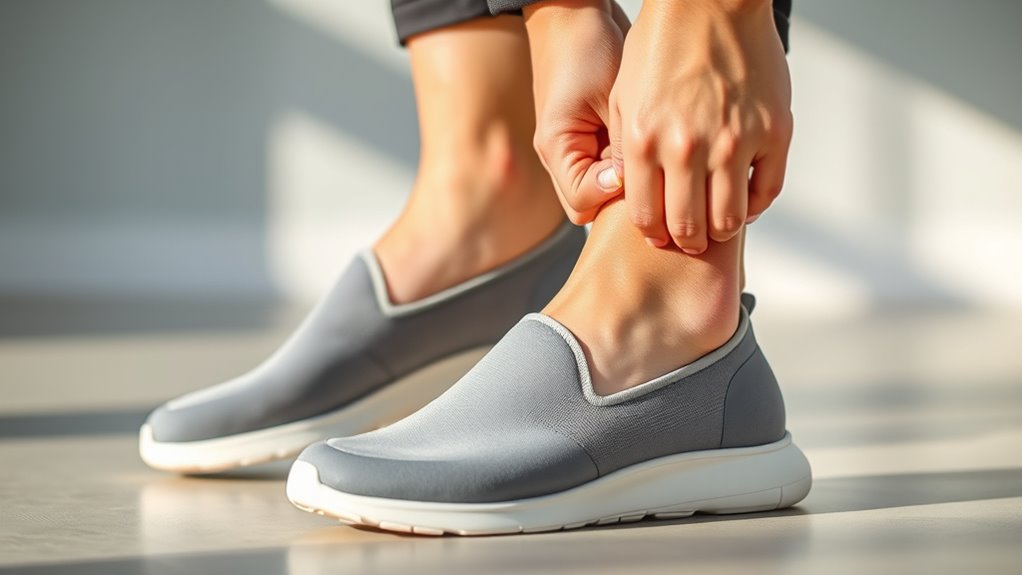
Slip-on and stretchable footwear make getting ready quicker and easier, especially if you have limited mobility. They provide a flexible fit that adapts comfortably to your foot’s shape. These features guarantee you can wear your shoes with less effort and maximum comfort. Additionally, inspirational quotes about fatherhood emphasize the importance of support and understanding, reminding us how even small acts like choosing easy-to-wear shoes can make a significant difference in daily life. Incorporating ergonomic footwear can further enhance comfort and reduce strain during daily activities. Using headphone compatibility options, such as Bluetooth or universal jacks, can also make listening to music or instructions more accessible and hassle-free. Supporting biodiversity in design, such as using sustainable and eco-friendly materials, can promote environmental well-being while maintaining functional footwear. Moreover, considering Gold IRA Rollovers as part of a diversified investment strategy can provide long-term financial security and peace of mind.
Ease of Wear
Have you ever struggled to put on traditional footwear? Slip-on and stretchable shoes make dressing easier and quicker. They eliminate the need to bend down and tie laces, reducing strain and frustration. These shoes are designed with flexible materials that conform to your foot’s shape, providing comfort and support.
Consider these benefits:
- No laces or fasteners, simplifying the process
- Elastic materials that adapt to different foot shapes
- Reduced effort required to wear shoes
These features are especially helpful for individuals with limited dexterity or mobility challenges. Slip-on and stretchable footwear promote independence and make daily dressing smoother, saving you time and energy. They’re practical solutions that combine convenience with comfort.
Flexible Fit
Flexible fit footwear, such as slip-on and stretchable shoes, adapts seamlessly to the unique shape of your foot. These shoes make dressing easier by eliminating the need for laces or fasteners, reducing frustration and effort. Stretchable materials, like elastic or neoprene, expand as you slip them on, providing a snug yet comfortable fit. Slip-on designs often feature elastic gussets or flexible soles that accommodate swelling or difficulty moving. This type of footwear is especially helpful for people with limited mobility, arthritis, or balance challenges. Because they conform to your foot, these shoes offer both comfort and stability. Plus, they can be quickly put on or taken off, saving you time and minimizing discomfort during daily routines.
Modified Sleeves and Pant Legs for Accessibility
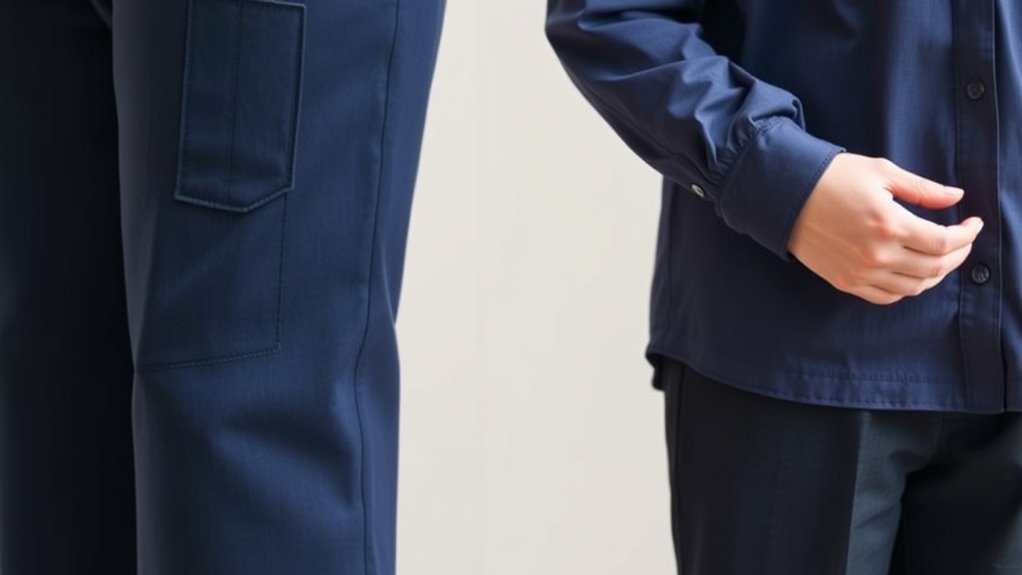
Modifying sleeves and pant legs can considerably improve clothing accessibility for individuals with limited mobility or dexterity. These adjustments make dressing easier and reduce frustration. For example, adding elastic or stretch panels allows for easier pulling on and off. You might also consider wide openings or side zippers to eliminate the need for complicated maneuvers. Additionally, using velcro closures instead of buttons or zippers can simplify dressing tasks. These modifications help minimize the effort and fine motor skills required, making dressing less stressful. Incorporating adaptive clothing features designed for accessibility can further enhance ease of use. For instance, selecting tips that match your clothing needs, such as appropriate tip size, can improve spray application and reduce rework. Considering tuning modifications for vehicles like Hyundai models demonstrates the importance of tailored adjustments to optimize performance and usability. Whether for yourself or someone you care for, these simple changes can promote independence and comfort. Focusing on clothing modifications that reduce barriers and increase ease of use, ensuring clothing fits comfortably and functions efficiently.
Clothing With Visual and Tactile Cues
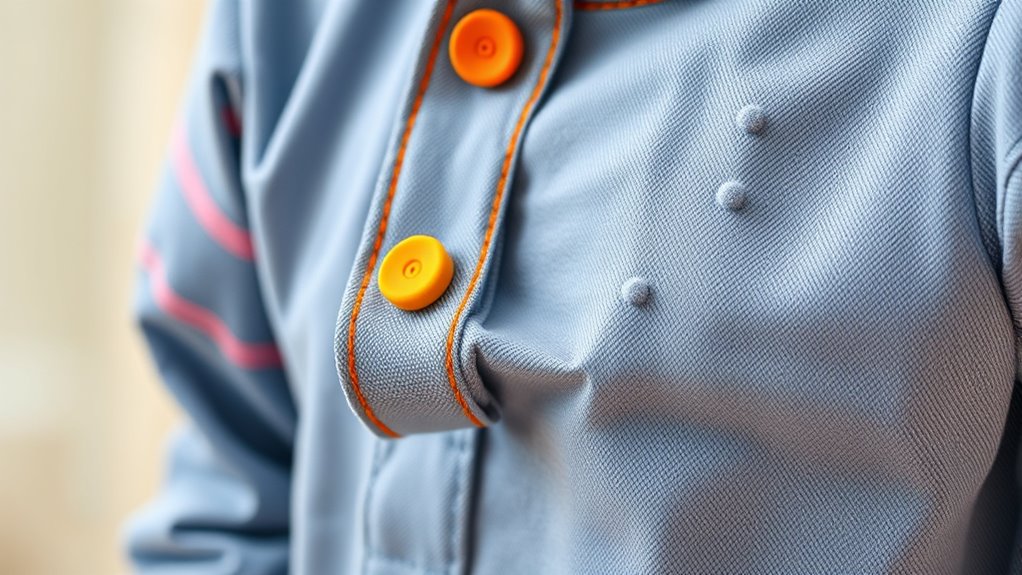
Clothing with visual and tactile cues enhances independence by making it easier to identify and manage garments. You can use color coding, such as different colors for shirts and pants, to quickly distinguish clothing items. Tactile markers like textured patches or tags help identify the front and back or specific sizes, reducing confusion. For example, a raised dot on the inside collar indicates the front of a shirt. These cues enable you to dress more confidently, especially if visual or motor skills are limited. By incorporating simple cues into clothing, you minimize frustration and save time. This approach supports your autonomy, making dressing a smoother, less stressful process. Overall, visual and tactile cues empower you to manage your wardrobe more independently.
Frequently Asked Questions
How Do Adaptive Clothes Accommodate Different Disabilities?
You want to know how adaptive clothes help with various disabilities. These garments are designed with features like magnetic closures, stretchy fabrics, and adjustable fastenings, making dressing easier for people with mobility, dexterity, or sensory challenges. They eliminate the need for difficult buttons or zippers, providing independence and comfort. By accommodating different needs, adaptive clothing guarantees everyone can dress with dignity, confidence, and ease.
Are There Specific Brands Known for High-Quality Adaptive Clothing?
Imagine finding a pair of pants with magnetic closures instead of buttons—you feel relieved and confident. Brands like Tommy Hilfiger and Zappos Adaptive are known for high-quality adaptive clothing. They use durable fabrics and innovative designs to make dressing easier. You’ll notice their collections focus on comfort, style, and accessibility, helping you or loved ones dress with independence and ease every day.
Can Adaptive Clothing Be Stylish and Trendy?
Yes, adaptive clothing can definitely be stylish and trendy. You’ll find many brands now designing fashionable pieces that suit various tastes, blending function with modern aesthetics. You don’t have to sacrifice style for comfort anymore. With innovative cuts, vibrant colors, and current trends, adaptive clothing allows you to express your personality confidently while easing dressing behaviors. So, you can look great and feel comfortable at the same time.
What Materials Are Best for Sensitive or Allergic Skin?
They say, “Clothes make the man,” but comfort makes the wearer. For sensitive or allergic skin, opt for natural, breathable fabrics like organic cotton, silk, or bamboo. These materials are gentle, hypoallergenic, and help prevent irritation. Avoid synthetic fibers and dyes that can trigger allergies. You want clothing that feels soft against your skin and lets it breathe, making dressing easier and more comfortable every day.
How Do Cost and Availability Compare to Regular Clothing?
When considering clothing adaptations that ease dressing behaviors, you’ll find that they often cost more and may be less readily available than regular clothing. Specialty fabrics and designs, like seamless or magnetic closures, usually come at a higher price and limited stores. However, investing in these options can markedly improve comfort and independence, making dressing easier and more manageable, especially for those with sensitivities or physical challenges.
Conclusion
By choosing clothing with easy fasteners, magnetic closures, and stretchable designs, you make dressing simpler and more comfortable. These adaptations act like a gentle hand guiding you, transforming daily challenges into moments of independence. Embrace the power of thoughtful design—because when your clothes work with you, not against you, every day becomes a step toward freedom and confidence. After all, isn’t life too short for clothing that’s hard to handle?
